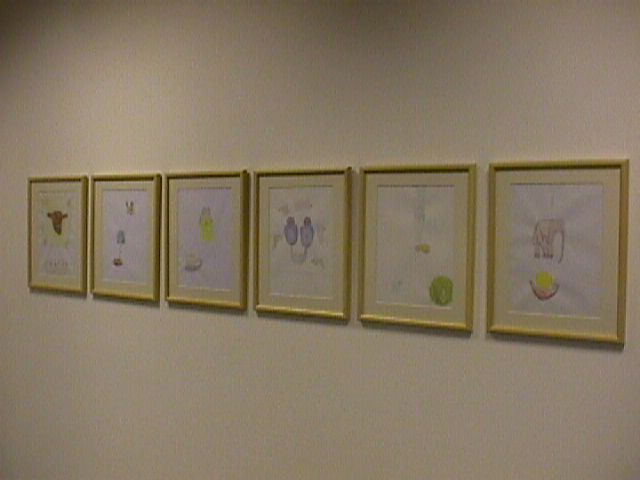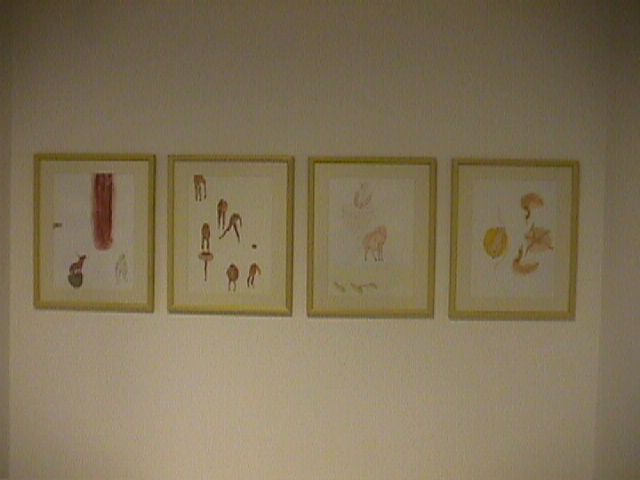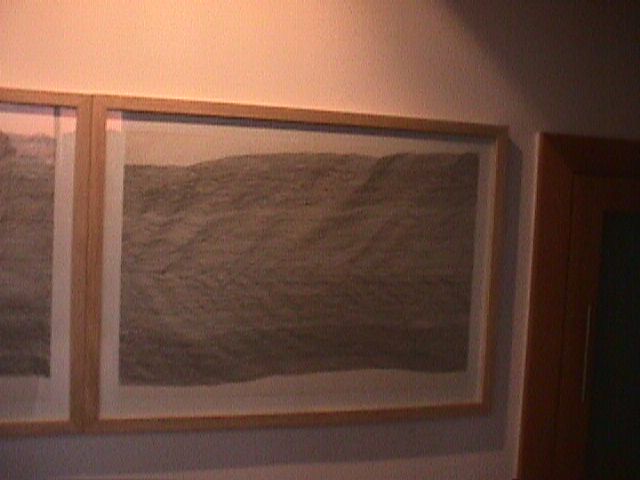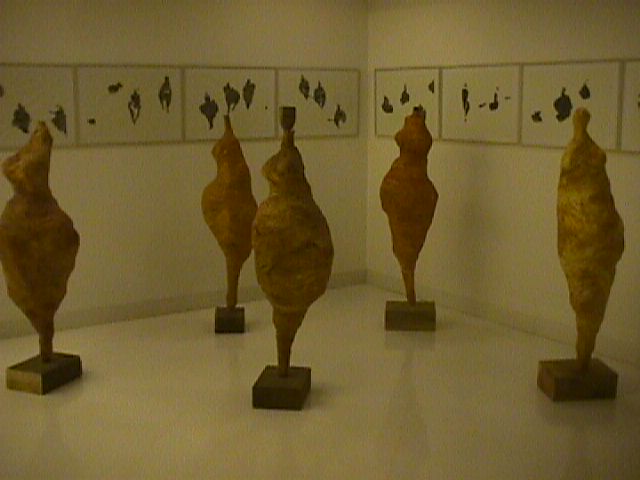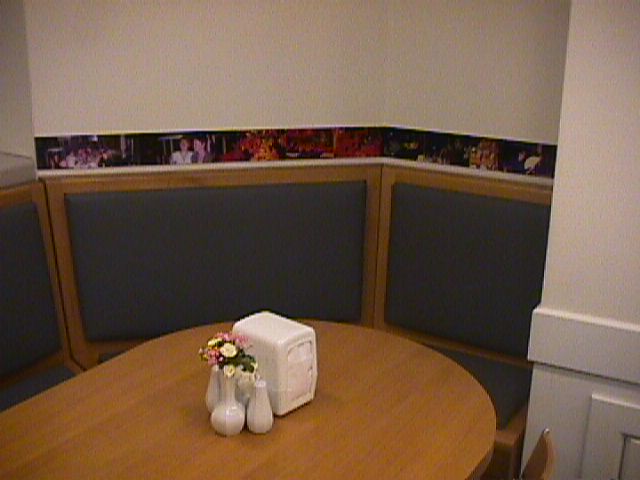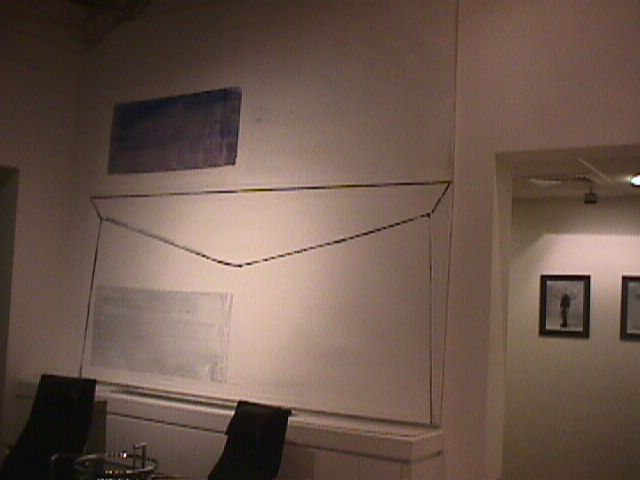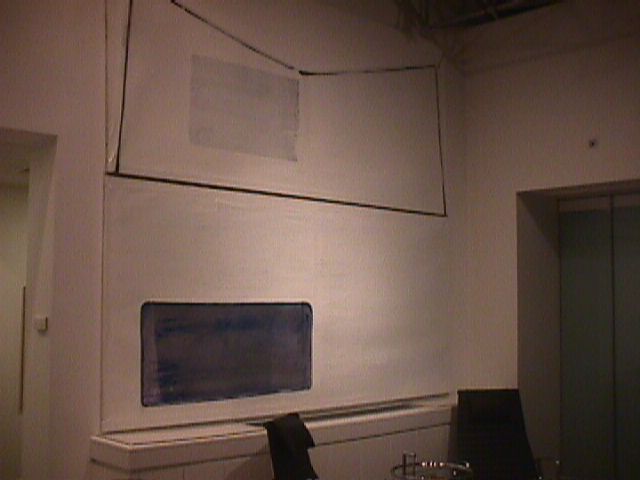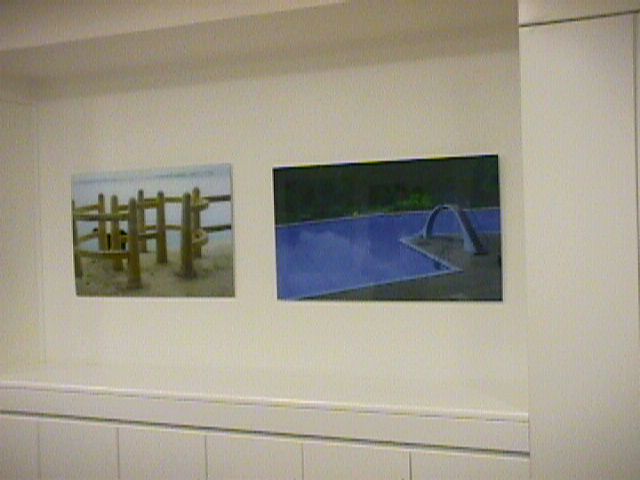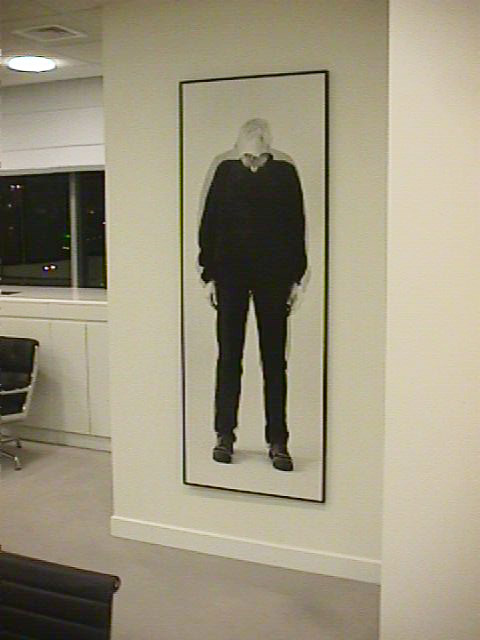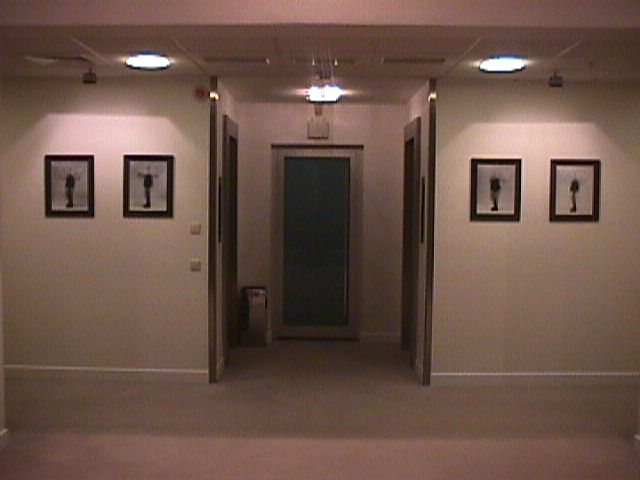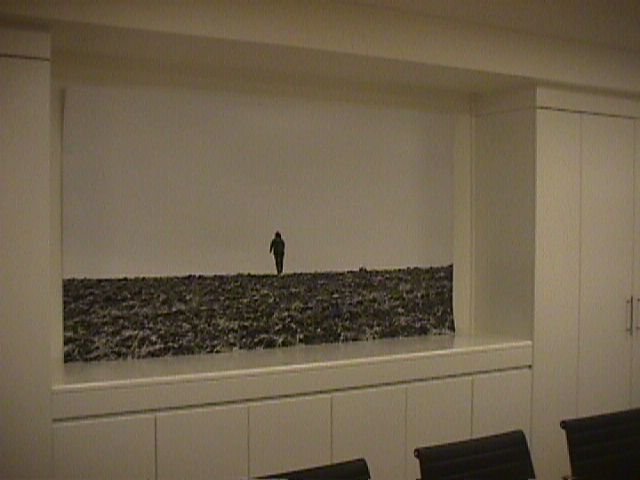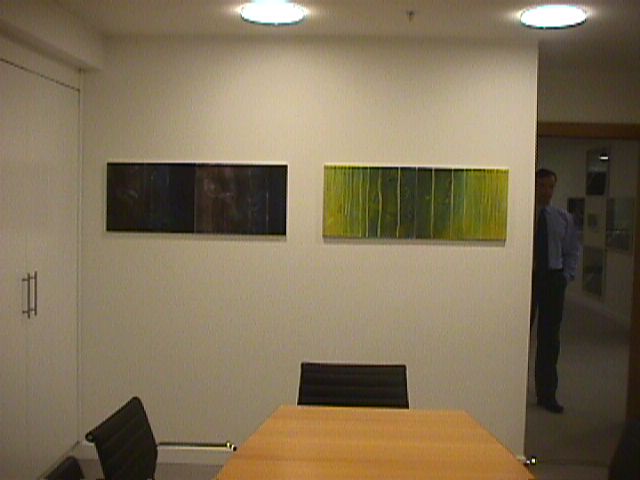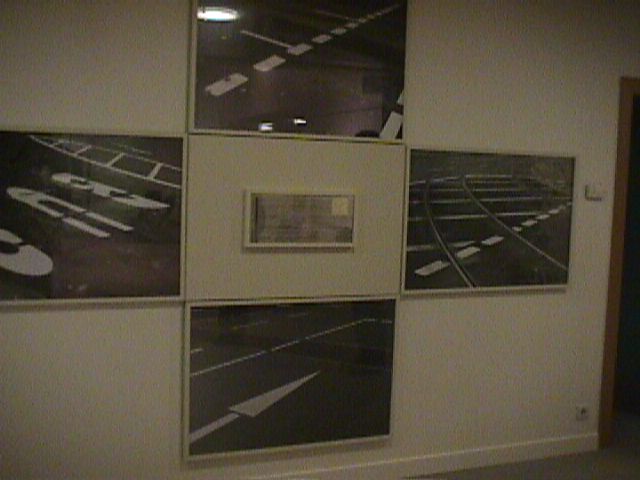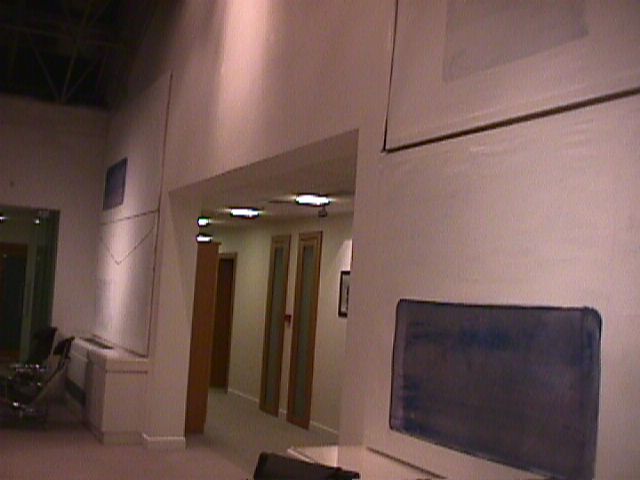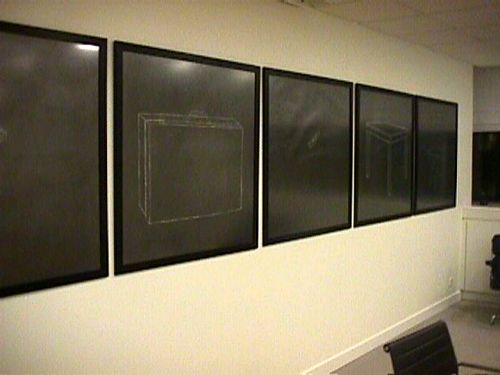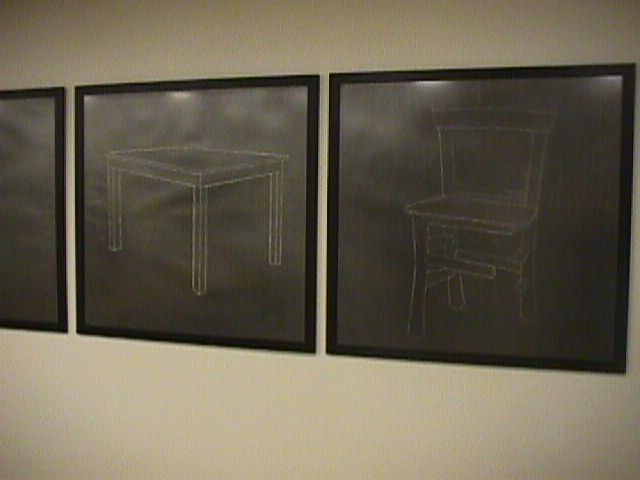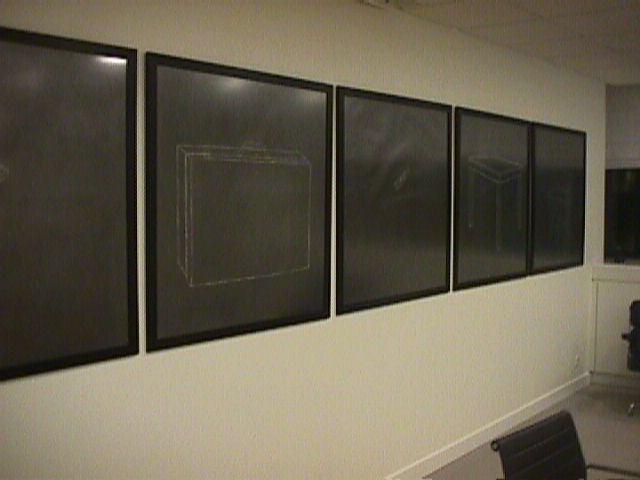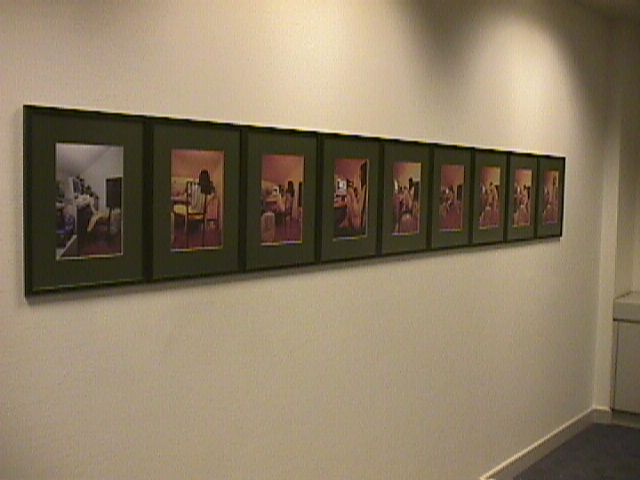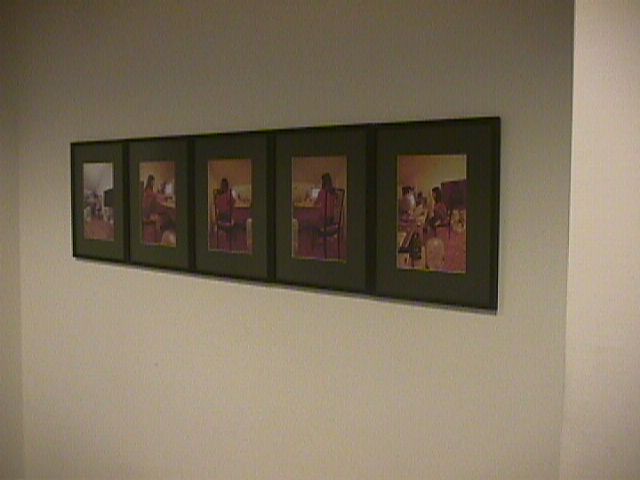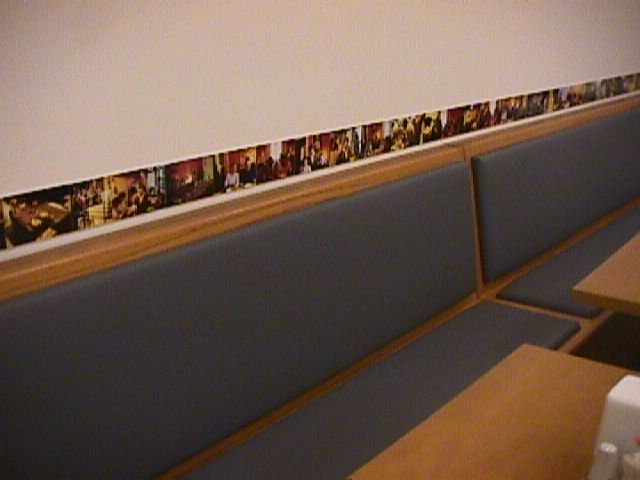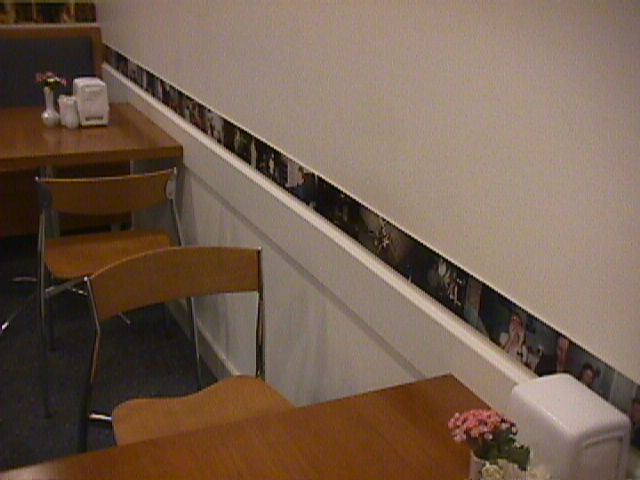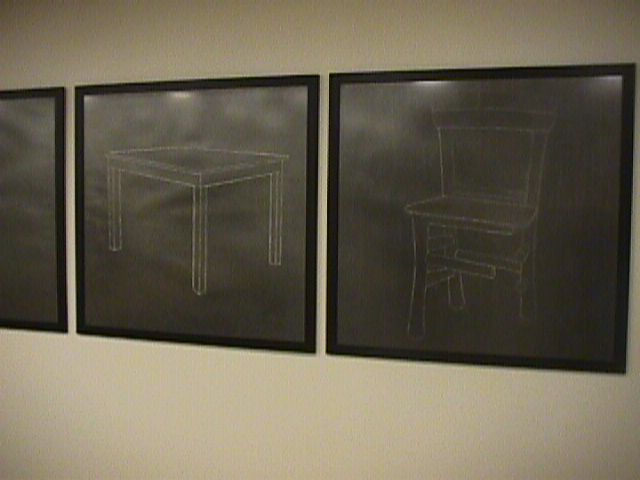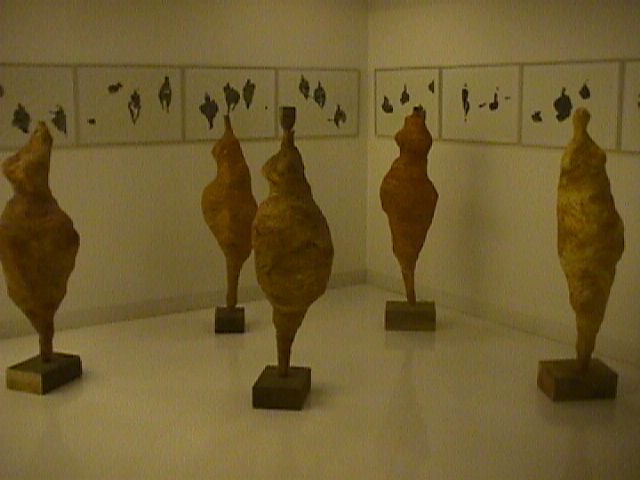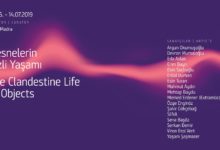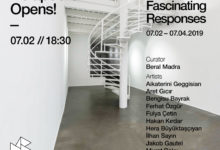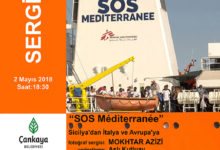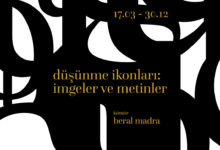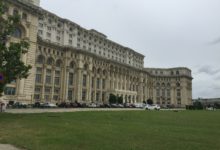ALL DAY EVERY DAY I
Westdeutsche Landesbank Contemporary Art Project
February-August 2001
Özgül Arslan, Inken Boje, Tatjana Doll, Esra Ersen, Martina Kissenbeck, Saskia Niehaus, Mürüvvet Türkyılmaz, Jost Wischnewski
First of all this exhibition attempts to show the current art production in Istanbul and Nordrhein Westfalen with a selection of relatively young generation of artists. The artists have been invited by me with the kind support of advisers in Düsseldorf and Cologne*. Consistent and integral production of the artists related to the concept of the exhibition facilitated my task. The concept of the exhibition was born out of my observation since I started to work as the curator of the exhibitions in the WestLB, Istanbul building. For the first time I had the opportunity to make an in-depth-examination of the office life. Situated on a hill in the recently developed district, the building is far away from the heterogene centers of the city overlooking to the main highway and the ultra-modern business center with its multiplying skyscrapers. Inside it is quite and strictly proffessional. When one enters the building and the electronic doors are closed, one feels to be isolated from the world outside or even from one’s own daily realities. The minimalist interior decoration accentuates the serenity. There is an inevitable division of inside/outside. Inside, there is the “concrete reality” of the business world with its detailed systems and strategies. Outside there is the so-called “real world” with its numerous differences and ambiguities related to the city and to the private lives. All day long and every day the people work and live in these excessively self-confident building and leave their all day/every day existence, responsibilities and tasks behind.
If one of the objectives of this exhibition is to fuse this outside/inside dichotomy, the other is to survey this division. Here, artworks will serve as mediums shifting from one side to the other, in order to signify the infinite details of human factor/existence within the man-made systems.
Since the prehistoric times the art has embraced every day realities and reflected it as representations with different styles, forms and aesthetics. The landscapes, still life, interior paintings display all kinds of daily life tasks, functions and objects, which also indicate geographical, cultural and individual differences. At all times the artist was a keen and sensitive observer of the daily life with particular interest in objects and habitudes which signify political, social and cultural facts and transformations.
All day and every day issues have not only been the subject of the art of 20Th century art, but gradually it became the subtance and the process to be articulated within. The pioneers were Picasso and Braque. Around 1912 Braque invented the papier collé technique in his search for freeing the color of its traditional function of representing the reality. Picasso founded the technique of collage by adhering different materials on the canvass surface and also invented Cubist sculpture, which was an assemblage of every day materials. At the same time in New York Marcel Duchamp was introducing his ready-mades which have widened the traditional canon of sculptural materials to various new materials from the every day repertory. The Hannover Dadaist Kurt Schwitters at first created his poetic collages with every day refuse and waste and later he constructed his enviromental collages, which became the basis of the installations in the 80’s and 90’s. In the 50’s and 60’s Neo-Dada movement provided important resources for fusing art and every day life under the titles Nouveaux Réalism and Fluxus. In the late 1960’s the formalism of modern art was dissolved within the context of radical transformations in economy, politics and social life. The art had to reflect the transformation in every day life, which was inevitably being conducted, influenced and controled by new communication technologies and consumerism. In Germany, with his expanded art concept Joseph Beuys has actually achieved the unity of art with traditional and practical issues of life. In England, Richard Hamilton’s collage “Just what is that makes today’s homes so different, so appealing?” has summed up the iconographic material of Pop Art by depicting the every day life of the consumer. In USA the trivial culture became the mythical environment of Pop Art in the works of Rauschenberg, Warhol, Rosenquist, Lichtenstein and others. The Minimal Art production in the 70’s seems to oppose the every day turmoil with Donald Judd’s iron cupboards and Dan Flavin’s neon tubes, which are proposals for a new order in daily life. Throughout 80’s and 90’s all this accumulation opened the way to a new inquiry in defining the borders between art and life and built a substructure for new forms of production. On the other hand, even this kind of art was confined to the limits of the museums, art galleries and other institutions. Although individuality guides their form, content and aesthetics, the sublime paintings and sculptures have not been the immediate products of this freedom; once they were in the museums they were distanced from the viewer and his/her every day realities. The culture industry always regulates the conditions of encounter between the artwork and the public. Therefore, in the 90’s the artists, confronting these regulations and confinements produced works that are not dependend on a given space, but mobile, rootless and multidiciplinary. These works embraced all sections of life; explicitly all the things that was considered as insignificant, common and manifold within the modernist criterion. At a crucial moment, the limittless desire and obsession of the artist to investigate and question coupled with the post-modern deconstructivism and shifted the infinitesimal details of every day life into focus. Yet, as much as the every day life of the individual may seem common, it is meaningful as his/her private sphere. It is this “private sphere” that appears in today’s artworks, more often – due to the ever present anarchy in the nature of creativity – in the form of transgressive images, performances and momentum.
In Postmodernizm modernist individuality, seriousness and devotion left its place to a new playfullness, ecclecticism and indifference. Moreover, postmodern art enjoyed life as it is and welcomed the heterogenity of styles and saluted the simulation of every day life.
The computer and internet images of Özgül Arslan seem to be the direct images/documents of today’s dominant daily occupation. The most popular way of communication in the virtual world is the chat board. A special twofold language is being developed. While people freely express themselves in the unrestricted virtual domain, they also crave to show their mimics and gestures. A sign language is being created and added to the written texts. In the second photographic series, an inside-outside enigma is being narrated with a daily routine. A simply decorated and isolated room is photographed at different time spans. The significant elements are the computer, the bird in the cage and a woman occasionally appearing to work on the computer. The ambiguity lies in the outwardly isolation from the world and invardly expansion to the world. In this exhibition Inken Boje presents two series. In one of them utilizing various labaratory and printing photographic techniques depicts the different movements of human body. In this way Boje obtains “painterly” images as well as signifies the human body as a multi-faceted sculpture. The images bring forward the language of body, which in daily life is being articulated unconsciously, but gains significance in the office where human movement is limited. The other series reflect the outcome of her performance, leaving her footprints on wet pigments. Even if one can recognize the footprints, the image is abstract. Large minimalists photograph exempflies the kind of perfomance that accompanies these paintings. Esra Ersen‘s instant photographies of people at recurrent dinner parties encircled by different environments indicate a certain shared time within the every day life. A different kind of participation can be experienced during these dinners; a kind that cannot occure in other times. We know that one of the basics of consumerism is to bring people together – as extremely manifested in the shopping malls – to fabricate common life; however this is a programmed togetherness. Ersen attempts to present unprogrammed moments of togetherness; vivacious, excited, released, libertine, emancipated faces come into view within the atmosphere of wealth, prosperity and affluence. However, she has no intention to convince the viewer about the sincerity of these priviledged moments; she rather implicates that one can achieve a kind of affection. Tatjana Doll produces large-scale paintings that iconise the objects and signs of the every day. These objects and signs are handled as analogues of unavoidable necessities and regulations of economic systems, social life, every day and all day with which one has to compromise. Paradoxal is that at the same time one is inclined to disregard the superiority of these necessities and regulations. The giant envelope is a dubious example ; it is a necessary object, but at the same time a trivial piece of paper to be thrown away. Once upon a time an envelope was even a literary object. Now, the envelope is on its way to becoming an object of nostalgy; the letter may survive in the form of an e-mail…What is the significance of this iconised business letter envelopes? It is empty. An emptiness which is immediately associated to a fullness; because an envelope cannot be noticed without its letter. Mürüvvet Türkyilmaz known with her wall drawings and recycled paper installation, present a series of graphit on paper drawings. Simple and common furnitures such as table and chair are depicted as negative images. By rendering the objects as negative images within the graphite surfaces she puts a certain distance and alienation between the viewer and the object which transforms these furnitures into icons of the material world. However, there are delusive details in these drawings when one insists to get involved: there are missing parts. The briefcase has no locks, the chair has only three legs. Yet, these missing details cannot prevent the viewer to signify the object; they are only there to question the gaze of the viewer. Jost Wischnewski‘s guiding road signs printed on the surface of streets are directly indicating the outside within the concept of this exhibition. Streets and roads are essential elements of every day and all day in the sense that they are the connecting lines between the fields of attraction and that they are the infrastructure of the human motion and activity. The roads may seem to be fields of freedom where humankind tries to transcend its capacity of motion with the support of automobil technology and traffic systems. Roads may seem to be fields of speed where the motion is the real life and the real life is like a theater stage. In both cases, one is doomed to by-pass the connotative subtance of life for the sake of premeditated de-territorialization. Roads are fields of confinement; they have instructions, regulations, commands and guidelines which one obediently follows every day and all day. Saskia Niehaus‘ water colors and Martina Kissenbeck‘s drawings and sculpture represent the poetic and meditative dimension of this exhibition and resourcefully relate to the inside/outside dichotomy / harmony with their spirituality. In her delicate small works on paper, Niehaus has invented a realm with mythological and surrealistic connotations employing the animal as an element of allusion. The bears, birds, fishes horses, cats together with men and women are not assembled in definite scenes, but float in the space as if only to invoke a trace of the real world. Niehaus’s drawings are introspective and more complicated than they seem. For this exhibition Niehaus’s watercolors meet the desire of the viewer for sublimity and refinement in juxtaposition to the triviality of every day. On Martina Kissenbeck‘s ink drawings with abstract motives and in the Kokon sculptures intimating a figure one can behold the female figure. The viewer is moved to look for the whole form. These subtl and vibrant drawings and sculptures reminds the viewer that art is an illusion of life and one can confuse it with the real thing. And, this confusion is an invigorating way of deepening our spiritual investment in art.
BÜTÜN GÜN / HER GÜN I
Bu sergi her şeyden önce, Istanbul ve Nordrhein Westfalen’deki güncel sanat üretimini görece genç kuşak sanatçılardan seçilmiş yapıtlarla göstermeyi amaçlıyor. Sanatçılar, Düsseldorf ve Köln’deki danışmanların (*) değerli yardımlarıyla davet edildi. Kuşkusuz, serginin kavramı ile ilgili olarak bu sanatçıların kararlı ve içkin üretimleri de benim bu görevimi kolaylaştırdı. Serginin kavramı, benim WestLB, Istanbul binasındaki sergi yapımcısı olarak çalışmam sırasında yaptığım gözlemlerden doğdu. İlk kez olarak bir iş binasında derinlemesine inceleme yapmak olanağı vardı. Bina, yakın zamanda gelişmiş bir mahallede, kentin heterojen merkezlerinden uzakta, otoyola ve giderek çoğalmakta olan gökdelenlerin yer aldığı is merkezine bakan bir yamaçtadır. İçeride yalıtılmış ve kesinlikle profesyonel bir ortam söz konusudur. İçeriye girdikten ve elektronik kapılar kapandıktan sonra insan kendini dış dünyadan ve dahası kendi günlük gerçeklerinden uzaklaşmış bulur. Binanın iç düzeni de belirli bir sükuneti vurgular. Dışarısı ve içerisi arasında kaçınılmaz bir ayrım vardır. İçerde ayrıntılı sistemleri ve stratejileriyle iş dünyasının “somut gerçeği”, dışarda ise, kente ve özel yaşamlara ilişkin sayısız farklılıkları ve çelişkileriyle “gerçek dünya” vardır. Gün boyunca ve her gün insanlar bu son derecede güvenli görünen binalarda yaşamakta ve bütün gün, her günlük yaşamlarını, kişisel sorumluluklarını ve özel işlerini arkada bırakmaktadır. Eğer bu serginin amaçlarından birisi bu dış dünya/iç dünya ikilemini uzlaştırmaksa, diğeri de bu ayrımı incelemektir. Bu bağlamda, sanat yapıtları insan yapımı sistemler içinde insan faktörünün/varlığının sonsuz ayrıntılarını göstermek üzere bir taraftan öteki tarafa kayabilen aracılar olarak işlev görür.
Tarihöncesi zamanlardan bu yana sanat gündelik gerçekleri kucaklar ve bunları farklı usluplar, biçimler ve estetiklerle temsil ederek yansıtır. Manzaralar, ölü doğa, içmekan resimleri her çeşit gündelik yaşama ilişkin görevleri, işlevleri ve nesneleri coğrafi, kültürel, bireysel ayrılıkları da işaret ederek gösterir. Tüm zamanlarda sanatçı, özellikle siyasal, toplumsal ve kültürel gerçekleri ve değişimleri gösteren insan davranışları ve nesnelerle ilgilenerek gündelik yaşamın keskin bir gözlemcisi oldu. Bütün gün ve her gün gerçekleri yalnız 20.yy sanatının da önemli bir konusu olmakla kalmadı, giderek içinde çalışılması gereken bir töz ve sürece dönüştü. Öncüler Picasso ve Braque’dı. Yaklaşık 1912’de Braque, boyanın gerçeği temsil etmesi geleneğine karşı arayışı sırasında papier collé tekniğini icat etti ve atölyesinde atılmış kağıtları keserek tuale yapıştırdı. Picasso da aynı zamanda değişik malzemeleri tuale yapıştırarak kolaj tekniğini, kullanılmış malzemeleri birbirlerine ekleyerek Kübist heykeli buldu. Yine aynı zamanda, New York’da Marcel Duchamp hazır nesne ile heykel için kullanılan malzemelerin geleneksel kuralını kırdı ve gündelik yaşama ilişkin yeni malzemeleri gündeme getirdi. Hannover’li Dadacı Kurt Schwitters ise, gündelik yaşamın, tüketimin atık malzemeleriyle 80’li ve 90’lı yılların yerleştirmelerinin temelini oluşturan mekansal kolajları üretti. 1950’ler ve 60’larda Neo-Dada akımı, Yeni Gerçekçilik ve Fluksus başlıkları altında gündelik yaşam ve sanatı içiçe geçiren yeni kaynaklar yarattı. 1960’ların sonunda modernist biçimcilik ekonomi, siyaset ve toplumsal yaşamlardaki değişimler içinde geçerliğini yitirmeye başladı. Sanat, yeni iletişim teknikleri ve tüketim ekonomisiyle geri dönüşü olmayan bir biçimde yönlendirilmekte, etkilenmekte ve denetlenmekte olan günlük yaşam gerçeklerini yansıtmak zorunda kaldı. Almanya’da, 70’li yılların karizmatik sanatçısı Joseph Beuys, genişletilmiş sanat kavramı ile gerçekten sanat ve yaşamın geleneksel ve pratik yönleri arasında bağlantı kurdu. İngiltere’de Richard Hamilton’un ünlü “Günümüz evlerini bu denli değişik ve çekici kılan nedir?” kolajı tüketimcinin günlük yaşamını betimleyerek Pop Art’ın ikonografik malzemesini özetledi. ABD’de, Rauschenberg, Warhol, Rosenquist, Lichtenstein ve başkalarının yapıtları üçüncül kültürü göstererek Pop Art’ın mitsel ortamını oluşturdu. Günlük yaşamın karmaşasına karşı gibi görünen 70’li yılların Minimal Sanat’ının da, örneğin Donald Judd’ın çelik çekmeceleri ve Dan Flavin’in neon tüpleri gerçekte günlük yaşama düzen getiren önerilerdi. Bütün bu sanatsal birikim 80’li ve 90’lı yıllardaki sanat-yaşam arası sınırların sorgulanmasına ve yeni üretim biçimlerine yapısal bir temel oluşturdu. Öte yandan bu tür sanat çoğu kez müzelerin, kurumların, sanat galerilerinin ve halka açık yerlerin snırları içine hapsoldu. Her ne kadar bunların biçimlerini, içeriklerini ve estetiklerini özgür bireysellik yönlendiriyorsa da, yüceltilmiş resimler ve heykeller bu özgürlüğün doğrudan doğruya ifadesi değildi. Kültür sanayii sistemi bunların kitlelere ulaşmasını her zaman kurallara bağladı. 90’lı yıllarda sanatçılar özellikle bu kurallara ve sınırlamalara karşı çıkan disiplinlerarası, çok teknikli ve belirli bir mekana bağlı olmayan işler üretmeye başladılar. Bu işler yaşamın bütün kesitlerini içerdi; özellikle de gündelik yaşamda önemsiz, sıradan ve yinelenebilir gibi olan her şeyi. Önemli bir aşamada, sanatçının sınır tanımayan irdeleme ve sorgulama arzusu ile post-modern yapısöküm birleştiğinde, insan yaşamının ince ayrıntıları ister istemez gündeme geldi. Bireyin gündelik yaşamı ne denli sıradan olursa olsun, sonuçta onun özel alanı olarak anlamlıdır. Günümüz sanat yapıtlarında , işte bu özel alan – yaratıclığın doğasında her zaman var olan başkaldırı sayesinde – iticci imgeler, performanslar ve süreçler olarak ortaya çıkmaktadır. Postmodernizmde modernist bireysellik, ciddilik ve sadakat yerini yeni bir oyuna, seçkinciliğe ve tarafsızlığa bırakmıştır. Dahası, postmodern sanat yaşamın tadını çıkarmaktan, uslup heterojenliğine kucak açmaktan ve günlük yaşamı taklit etmekten yanadır.
Özgül Arslan‘ın bilgisayar ve internet dizileri, günümüz insanının gündelik yaşamının en önemli parçasının belgeleri olarak dolaysız gibi görünen bir biçimde sunuluyor. Bir dizi fotograf internet ortamındaki en popüler ilişki olan “chat”lerin oluşturduğu yeni dili gündeme getiriyor. İnsanlar duygu ve düşüncelerini dijital ortamda açıklarken yüz ifadelerini ve gövde devinimlerini de belirtmek gereğini duyuyor ve yeni bir ifade/devinim alfabesi oluşturuyor. İkinci dizi, dış dünyadan yalıtılmış, ama aynı zamanda iletişim teknolojileriyle tüm dünyayla ilişki içinde bir odayı günün değişik saatlerinde gösteriyor. Bu odada teknoloji ve doğa (bitkiler ve kuş) ve arada sırada bilgisayar başına geçen kadın görülüyor. Çelişki belirgindir; dışa doğru herşey dünyadan yalıtılmıştır, içe doğru herşey dünyaya açılmaktadır. Bu sergide Inken Boje‘den iki farklı dizi sunuluyor. Bir dizide insan gövdesinin farklı devinimleri fotografın çeşitli labaratuvar ve baskı teknikleri kullanılarak gösteriliyor. Boje, fotografla hem “resimsel” görüntüler elde ediyor hem de insan gövdesini çok yönlü bir heykel olarak işaret ediyor. Bu dizinin bu sergideki işlevi, bedensel devinimin kısıtlı olduğu bir ortamda, gündelik yaşamda farkında olmadan kullanılan beden dilini gündeme getirmektir. İkinci dizide, sanatçı bir yürüyüş performansının sonucunu göstermektedir. Kullandığı doğal boyalar ıslakken üstünde yürür; sonuçta ayak izleri belirli olsa da sonuç soyut bir resme dönüşmektedir. Büyük bir minimalist fotograf bu tür bir performansı örnekler. Esra Ersen‘in sıradan akşam yemeklerini gösteren fotografları günümüz insanının günlük yaşamı içinde ortak bir zamanını işaret ediyor. Bu yemeklerde başka zaman dilimleri içinde gerçekleşmeyen bir paylaşma söz konusudur. Tüketimin sunduğu seçeneklerden birisi de – alış veriş merkezlerinde iyice ortaya çıktığı gibi – insanları biraraya getirmektir- yapay ortak yaşam ürektmektir; bu yine de bir programdır. Ersen, programlanmamış birliktelik anları sunmaya çalışıyor; canlı, heyecanlı, rahat, açık, kendine güvenen yüzler bir refah, zenginlik ve bolluk atmosferinde görüntüye gelirler. Ne ki, onun izleyiciyi bu ayrıcalıklı anların içtenliğine inandırmaya da niyeti yoktur; yalnız insanın bir biçimde şefkate ulaşabileceğini ima eder. Tatjana Doll, günlük yaşam içindeki nesneleri ve işaretleri ikonlaştıran resimler üretmektedir. Bu nesneler ve işaretler ekonomik ve toplumsal yaşamın kaçınılmaz gerekliliklerinin ve kurallarının karşılığıdır; insan günlük yaşamını bunlara boyun eğerek geçirmek zorundadır. Çelişkili olan durum, insanın bu gereklilikleri ve kuralları görmezliğe gelmek eğiliminde olmasıdır. Bu dev mektup zarfı kuşkulu bir örnektir; gerekli bir nesnedir, ama aynı zamanda yırtılıp atılacak önemsiz bir kağıttır. Bir zamanlar bir zarf yazınsal değeri olan bir nesneydi. Şimdi ise nostaljik bir nesne olma yolundadır; mektubun ise e-mail biçiminde varlığını sürdürme olanağı hala vardır. Martina Kissenbeck‘in heykelleri, desenleri ve Saskia Niehaus‘un suluboyaları bu sergide “şiirsel” ve meditatif bir boyut temsil etmekte ve bu serginin kavramındaki içdünya/dış dünya karşıtlığı ve uzlaşması içinde tinsel bir anlam taşımaktadır. Martina Kissenbeck‘in çini mürekkebi ile yapılmış dışavurumcu desenleri soyut gövde betimleridir. Keten bezinden yapılmış kadın figürleri ise bu desenlerin üç boyutlu uzantılarıdır. İzleyici biçimleri bütünlemeye doğru yönlendirilir. Bu yumuşak ama canlı desenler ve heykeller izleyiciye sanatın yaşamın bir yanılsaması olduğunu ve insanın bunu gerçekle karıştırabileceğini anımsatır. İşte bu karıştırma, bizim sanata yaptığımız tinsel yatırımı derinleştirmemiz için cesaret verici bir yoldur. Saskia Niehaus, kağıt üstüne yapılmış zarif desenlerinde hayvanları bir benzetme ögesi olarak kullanarak mitolojik ve gerçeküstü bir dünya kurgulanmıştır. Ayılar, kuşlar, balıklar, kediler kadın ve erkeklerle birlikte belirgin bir manzarada bir araya getirilmemiştir, gerçek dünyanın izini sürmek isteği uyandırmak üzere mekanda yüzerler. Niehaus’un desnleri içedönktür ve göründüklerinden çok daha karmaşık anlamlıdır. Bu sergide Niehaus’un suluboyaları izleyicinin, günlük yaşamın sıradanlıkları karşısında yücelik ve incelik isteğine bir yanıt verir. Desenleri ve dönüştürülmüş kağıtlarla yaptığı yerleştirmeleriyle tanınan Mürüvvet Türkyılmaz‘ın resimlerinde geleneksel malzemelerle kağıt ve grafitle yapılmış masa, sandalye gibi yalın ve sıradan eşyalar görülür. Kurşuni zeminlerde beyaz bırakılmış çizgilerle üretilen bu imgelerin “negatif” etkisi vermesi, görüntü ile bakış arasında yabancılaştırıcı bir uzaklık koyar ve bu eşyaları maddi dünyanın ikonlarına dönüştürür. Öte yandan bu resimlere dikkatle bakıldığında, her birisinde bir eksiklik göze çarpar; örneğin, çantanın kilitleri, sandalyenin bacağı, masanın ayağı yoktur. Bu eksiklikler, bu eşyaların tanımlanmasını engellemez, ama İzleyicinin bakışını sorgular. Jost Wischnewski’nin yol zeminine yazılmış yönlendirme işaretleri bu sergide dışdünyanın gerçeklerini işaret eder. Yollar hem gündelik yaşamın kaçınılmaz ögesidir hem ilgi alanları arasındaki bağlantı çizgileridir hem de insan devinimi ve etkinliğinin altyapısıdır. Yolların özgürlük alanları olduğu da düşünülebilir; insanın otomobil teknolojisi ve trafik sistemleriyle sınırlarını aşmaya çalıştığı yer olarak. Yollar hız alanlarıdır; devinim gerçek yaşam, gerçek yaşam ise bir tiyatro sahnesine dönüşür. Her iki durumda da, insan yaşamın anlamlı tözünü tasarlanmış yersizleşme uğruna feda eder. Yollar sınırlama alanlarıdır; insanın hergün boyun eğerek izlediği talimatlar verirler, kuralları, emirleri ve yönlendirme çizgileri vardır.
Beral Madra / Ocak 2001

